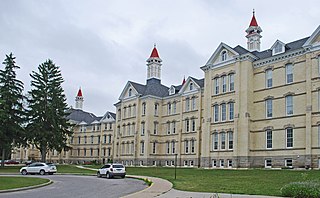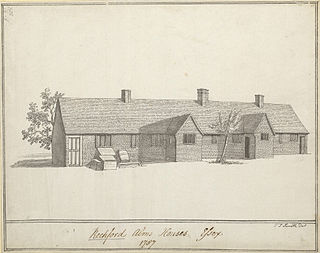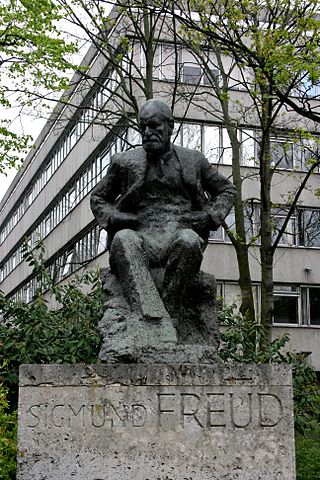Related Research Articles

Pediatrics is the branch of medicine that involves the medical care of infants, children, adolescents, and young adults. In the United Kingdom, paediatrics covers many of their youth until the age of 18. The American Academy of Pediatrics recommends people seek pediatric care through the age of 21, but some pediatric subspecialists continue to care for adults up to 25. Worldwide age limits of pediatrics have been trending upward year after year. A medical doctor who specializes in this area is known as a pediatrician, or paediatrician. The word pediatrics and its cognates mean "healer of children", derived from the two Greek words: παῖς and ἰατρός. Pediatricians work in clinics, research centers, universities, general hospitals and children's hospitals, including those who practice pediatric subspecialties.

Psychiatric hospitals, also known as mental health hospitals or behavioral health hospitals, are hospitals or wards specializing in the treatment of severe mental disorders, such as schizophrenia, bipolar disorder, eating disorders, dissociative identity disorder, major depressive disorder and many others. Psychiatric hospitals vary widely in their size and grading. Some hospitals may specialize only in short-term or outpatient therapy for low-risk patients. Others may specialize in the temporary or permanent containment of patients who need routine assistance, treatment, or a specialized and controlled environment due to a psychiatric disorder. Patients often choose voluntary commitment, but those whom psychiatrists believe to pose significant danger to themselves or others may be subject to involuntary commitment and involuntary treatment. Psychiatric hospitals may also be called psychiatric wards/units when they are a subunit of a regular hospital.

Thomas John Barnardo was an Irish-born philanthropist and founder and director of homes for poor and deprived children. From the foundation of the first Barnardo's home in 1867 to the date of Barnardo's death, nearly 60,000 children had been taken in.

An almshouse was charitable housing provided to people in a particular community, especially during the Middle Ages. They were often targeted at the poor of a locality, at those from certain forms of previous employment, or their widows, and at elderly people who could no longer pay rent, and are generally maintained by a charity or the trustees of a bequest. Almshouses were originally formed as extensions of the church system and were later adapted by local officials and authorities.

Tonsillitis is inflammation of the tonsils in the upper part of the throat. It can be acute or chronic. Acute tonsillitis typically has a rapid onset. Symptoms may include sore throat, fever, enlargement of the tonsils, trouble swallowing, and enlarged lymph nodes around the neck. Complications include peritonsillar abscess (Quinsy).

The Tavistock and Portman NHS Foundation Trust is a specialist mental health trust based in north London. The Trust specialises in talking therapies. The education and training department caters for 2,000 students a year from the United Kingdom and abroad. The Trust is based at the Tavistock Centre in Swiss Cottage. The founding organisation was the Tavistock institute of medical psychology founded in 1920 by Dr. Hugh Crichton-Miller.

Shriners Children's is a network of non-profit medical facilities across North America. Children with orthopaedic conditions, burns, spinal cord injuries, and cleft lip and palate are eligible for care and receive all services in a family-centered environment, regardless of the patients' ability to pay. Care for children is usually provided until age 18, although in some cases, it may be extended to age 21.
An academic clinical trial is a clinical trial not funded by pharmaceutical or biotechnology company for commercial ends but by public-good agencies to advance medicine. These trials are a valuable component of the health care system; they benefit patients and help determine the safety and efficacy of drugs and devices, and play an important role in the checks and balances that regular commercially oriented clinical trials.

Noma is a rapidly progressive and often fatal infection of the mouth and face. This disease predominantly affects children between the ages of two and six years old in the least developed countries around the world, primarily in the "noma belt" of sub-Saharan Africa. Noma has also been seen in severely immunocompromised people in the developed world.

The Ancoats Hospital and Ardwick and Ancoats Dispensary was a large inner-city hospital located in Ancoats, to the north of the city centre of Manchester, England. It was built in 1875, replacing the Ardwick and Ancoats Dispensary that had existed since 1828. The building is now Grade II listed.

The Royal United Hospital (RUH) is a major acute-care hospital in the Weston suburb of Bath, England, which lies approximately 1.5 miles (2.4 km) west of the city centre. The hospital has 565 beds and occupies a 52 acres (21 ha) site. It is the area's major accident and emergency hospital, with a helicopter landing point on the adjacent Lansdown Cricket Club field. The hospital is operated by the Royal United Hospitals Bath NHS Foundation Trust.

Kate Waller Barrett, née Katherine Harwood Waller, was a prominent Virginia physician, humanitarian, philanthropist, sociologist and social reformer, best known for her leadership of the National Florence Crittenton Mission, which she founded in 1895 with Charles Nelson Crittenton. Her causes included helping the "outcast woman, the mistreated prisoner, those lacking in educational and social opportunity, the voteless woman, and the disabled war veteran." Although comparatively little known today, she was "[o]ne of the most prominent women of her time".

Chickenpox, or chicken pox, also known as varicella, is a highly contagious, vaccine-preventable disease caused by the initial infection with varicella zoster virus (VZV), a member of the herpesvirus family. The disease results in a characteristic skin rash that forms small, itchy blisters, which eventually scab over. It usually starts on the chest, back, and face. It then spreads to the rest of the body. The rash and other symptoms, such as fever, tiredness, and headaches, usually last five to seven days. Complications may occasionally include pneumonia, inflammation of the brain, and bacterial skin infections. The disease is usually more severe in adults than in children.

A hospital is a healthcare institution providing patient treatment with specialized health science and auxiliary healthcare staff and medical equipment. The best-known type of hospital is the general hospital, which typically has an emergency department to treat urgent health problems ranging from fire and accident victims to a sudden illness. A district hospital typically is the major health care facility in its region, with many beds for intensive care and additional beds for patients who need long-term care. Specialized hospitals include trauma centers, rehabilitation hospitals, children's hospitals, seniors' (geriatric) hospitals, and hospitals for dealing with specific medical needs such as psychiatric treatment and certain disease categories. Specialized hospitals can help reduce health care costs compared to general hospitals. Hospitals are classified as general, specialty, or government depending on the sources of income received.

In the United States, hospice care is a type and philosophy of end-of-life care which focuses on the palliation of a terminally ill patient's symptoms. These symptoms can be physical, emotional, spiritual or social in nature. The concept of hospice as a place to treat the incurably ill has been evolving since the 11th century. Hospice care was introduced to the United States in the 1970s in response to the work of Cicely Saunders in the United Kingdom. This part of health care has expanded as people face a variety of issues with terminal illness. In the United States, it is distinguished by extensive use of volunteers and a greater emphasis on the patient's psychological needs in coming to terms with dying.

A mass casualty incident describes an incident in which emergency medical services resources, such as personnel and equipment, are overwhelmed by the number and severity of casualties. For example, an incident where a two-person crew is responding to a motor vehicle collision with three severely injured people could be considered a mass casualty incident. The general public more commonly recognizes events such as building collapses, train and bus collisions, plane crashes, earthquakes and other large-scale emergencies as mass casualty incidents. Events such as the Oklahoma City bombing in 1995, the September 11 attacks in 2001, and the Boston Marathon bombing in 2013 are well-publicized examples of mass casualty incidents. The most common types of MCIs are generally caused by terrorism, mass-transportation accidents, fires or natural disasters. A multiple casualty incident is one in which there are multiple casualties. The key difference from a mass casualty incident is that in a multiple casualty incident the resources available are sufficient to manage the needs of the victims. The issue of resource availability is therefore critical to the understanding of these concepts. One crosses over from a multiple to a mass casualty incident when resources are exceeded and the systems are overwhelmed.

Nemours Children's Hospital, Delaware is a pediatric hospital located in Wilmington, Delaware. It is operated by the Nemours Foundation, a non-profit organization created through the last will and testament of philanthropist Alfred I. du Pont by his widow Jessie Ball duPont in 1936, and dedicated to improving the health of children. Historically, it was referred to as the A. I. duPont Institute for Crippled Children or more simply, the DuPont Institute and provides pediatric specialties and subspecialties to infants, children, teens, and young adults up to age 21.
The history of hospitals began in antiquity with hospitals in Greece, the Roman Empire and on the Indian subcontinent as well, starting with precursors in the Asclepian temples in ancient Greece and then the military hospitals in ancient Rome. The Greek temples were dedicated to the sick and infirm but did not look anything like modern hospitals. The Romans did not have dedicated, public hospitals. Public hospitals, per se, did not exist until the Christian period. Towards the end of the 4th century, the "second medical revolution" took place with the founding of the first Christian hospital in the eastern Byzantine Empire by Basil of Caesarea, and within a few decades, such hospitals had become ubiquitous in Byzantine society. The hospital would undergo development and progress throughout Byzantine, medieval European and Islamic societies from the 5th to the 15th century. European exploration brought hospitals to colonies in North America, Africa, and Asia. St Bartholomew's hospital West Smithfield in London, founded in 1123 is widely considered the oldest functioning hospital today. Originally a charitable institution, currently an NHS hospital it continues to provide free care to Londoners, as it has for 900 years. In contrast, the Mihintale Hospital in Sri Lanka, established in the 9th century A.D. is probably the site with the oldest archaeological evidence available for a hospital in the world. Serving monks and the local community, it represents early advancements in healthcare practices.

Arya Vaidya Sala, popularly known as Kottakkal Arya Vaidya Sala, is a healthcare centre located in Kottakkal, in the Indian state of Kerala, providing services under the Indian traditional medicine system of Ayurveda.
Lakhumal Hiranand Hiranandani (1917–2013) was an Indian otorhinolaryngologist, social activist and philanthropist, known for pioneering several surgical procedures which later came to be known as Dr. Hiranandani's Operations. He was the founder chairman of Hiranandani Foundation Trust which runs two schools in India and was reported to have been active in the social movement against organ trade in India. He was a recipient of the Golden Award of the American Academy of Otolaryngology–Head and Neck Surgery, the first Indian and the fifth overall to receive the honour. The Government of India awarded him the third highest civilian honour of the Padma Bhushan, in 1972, for his contributions to medicine and society.
References
- ↑ David Rosner (2004). A Once Charitable Enterprise: Hospitals and Health Care in Brooklyn and New York 1885-1915. Cambridge University Press. ISBN 978-0-521-52862-7.
- ↑ James Walker Smith (1985). Hospital Liability. Law Journal Press. pp. 2–. ISBN 978-1-58852-035-7.
- ↑ Molly F. Sherlock (2010). Overview of the Nonprofit and Charitable Sector. DIANE Publishing. pp. 37–. ISBN 978-1-4379-2603-3.